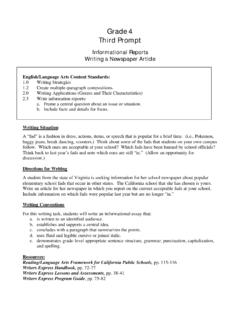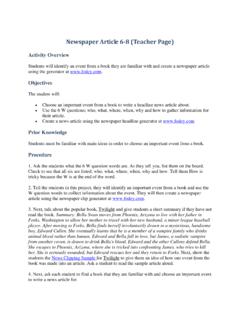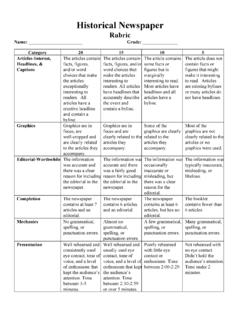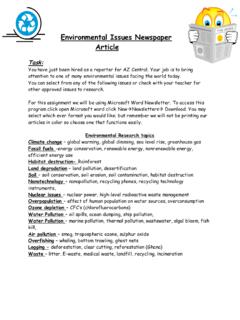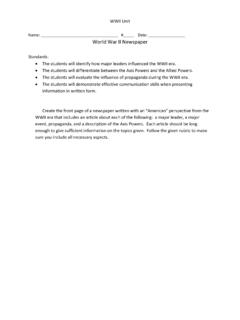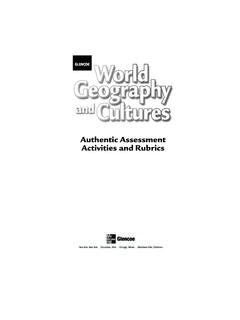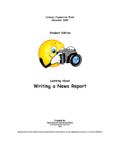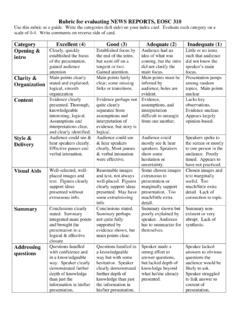Transcription of CREATE AND RUN YOUR OWN NEWSPAPER: A JOURNALISM …
1 1 CREATE AND RUN your OWN NEWSPAPER: A JOURNALISM UNIT WITH A SIMULATION GAMEPart 1: Publish a NewspaperPreparedWith the Support of theGordon Stanley Brown FundByDaniel Barcan, Leah Zuckerman, Gary Hirschand Debra LyneisDecember 20, 1999 Available fromThe Creative Learning Exchange1 Keefe RoadActon, MA 01720(978) 287-0070 granted for copying and electronic distributionfor non-commercial educational : Part 12 CONTENTSI ntroduction3 Background for the Unit4 Unit Overview: CREATE your Own Newspaper5 Student Assignment Sheets and Assessment Rubrics6 Mini-project I: The Great Train Wreck6 Mini-project II: The Front Page8 Mini-project III: Start the Presses10 Teacher Notes on Mini-projects12 Running your Own newspaper , the Game13 your Feedback13 newspaper : Part 13 INTRODUCTIONIn this interdisciplinary language arts and social studies JOURNALISM unit, middle school studentswrite articles and CREATE their own newspapers.
2 Then, they use a system dynamics model as agame to understand how their own newspaper businesses run. Finally, students learn more aboutthe model itself through a series of self-guided exercises on the model. The unit can be adaptedfor use with older unit is presented in three separate parts. In this paper, CREATE and Run your Own newspaper , A JOURNALISM Unit with aSimulation Game, Part 1: Publish a newspaper , students write and paste up theirown classroom newspapers. All of the student assignment sheets and assessmentrubrics for creating the student newspapers are included. This hands-on project takesabout three weeks as students progress from being rookie reporters to editors-in-chief. In second paper, CREATE and Run your Own newspaper , a JOURNALISM Unit with aSimulation Game, Part 2: Play the Game, students become newspaper owners andtry to run successful businesses on a STELLA model.
3 The model is a systemdynamics management flight simulator that was built with the help of Gary Hirsch, aprofessional system dynamicist. Playing with the model, students begin to understandthe consequences of their actions, the complexity of the JOURNALISM system, and thebasic feedback loops that drive their businesses. In the final paper, CREATE and Run your Own newspaper , A JOURNALISM Unit with aSimulation Game, Part 3: Examine the Model, students take a closer look at themodel itself. They test their strategies to see how sensitive they are to various changesand learn more about feedback loops. All three of these papers and the system dynamics model are available from theCreative Learning Exchange at , or through the MITS ystem Dynamics in Education website at : Part 14 BACKGROUND FOR THE UNITThe SchoolThis unit was developed at the Murdoch Middle School, Public Charter School of Chelmsford,Massachusetts, founded in 1996.
4 Housed at one end of an office park, it is a school serving 176students in grades 5 through 8. Teaching is structured to support student-centered learning,interdisciplinary units, a hands-on approach, authentic assessments, and teachers as is placed on problem-solving skills, understanding cause and effect relationships, andapplying knowledge. Systems thinking and system dynamics are written into the charter. DanBarcan and Leah Zuckerman are teachers on the 7/8 Team. Dan teaches social studies; Leahteaches language StudentsThe seventh and eighth graders who worked together on this project had been studyingjournalism for four weeks before beginning the project. Their schedule is structured to allow forlarge interdisciplinary projects supported by traditional skills instruction. For this unit, studentsfirst spent four weeks in separate language arts and social studies classes developing journalismskills and studying freedom of the press and related issues.
5 They learned how to conductinterviews and write news and feature articles. They examined newspapers to compare differentvoices for different , for the next four weeks, the students worked on the interdisciplinary project described inthese papers during longer combined social studies/language arts class blocks. Putting their newjournalism knowledge and skills to use, students created their own newspapers and played withtheir simulated newspaper beginning this project, the students also had an introduction to system dynamicsmodeling. Earlier in the year, they had played hands-on games from the Systems ThinkingPlaybook, by Linda Booth Sweeney and Dennis Meadows, 1996 (available from PegasusCommunications, , 1-800-272-0945). They had learned about causalloops and stocks and flows, and they had built basic bank balance models on the Ways to Use the UnitIn this paper, Part 1, students CREATE their own newspapers before playing the simulation gamedescribed later in Part 2.
6 The model comes second because it was still under development duringthe earlier weeks. Another option would be to play the game first so that students could use whatthey have learned from it as they CREATE their own newspapers because playing the game helpsstudents define quality in a unit and the model can be adapted for use with older students. The game and the modelingexercises in Part 3 are certainly challenging enough for high school students studying journalismor system : Part 15 THE UNIT: CREATE your OWN NEWSPAPERJ ournalism: Where Am I? How Can I Communicate What Goes On Here? Overall Objectives for the Unit: Students will read and write news, feature, and opinion articles, and report throughphotography. Students will produce front pages with mastheads, headlines, and correct text and photolayout. Students will work in teams to master journalistic writing and layout to complete one issue ofa four-page newspaper .
7 Students will use a STELLA model to understand how a newspaper business by Class:Social StudiesLanguage ArtsInterviewingWriting news articlesPhotojournalism and captionsWriting feature articlesLayout and designWriting opinion articlesPerspective and angle of a storyCreating newspapers with correct layoutEditingGeneral Schedule:Week 1: You are a rookie reporterMini-project: collecting information through interviews and writing news articles Week 2: You are the front-page editorMini-project: writing feature, opinion, and news articles and using layout techniques tocreate a front pageWeek 3: You are the editor-in-chiefMini-project: preparing four-page newspapers, building on the front pagesWeek 4: You have bought your own newspaperMini-project: using a STELLA model as a game to run a business and learn aboutfeedback loops (Described in the next paper, Part 2, Play the Game )AssessmentAssessment rubrics accompany the mini-project assignments.
8 Students are handed the rubricsalong with the assignment sheets so that they will know just what is expected of them from thevery beginning. The goals are clear; students can refer to the rubric as they work. Students workin pairs to check each other s work against the rubric standards. Often they read their articlesaloud to one another. Student then makes revisions to improve the finished product. Ultimately,of course, the teachers go through the same process with each student to assign a grade, butstudents are encouraged to work together and edit their work frequently along the : Part 16 JOURNALISM : Mini-project I, Assignment SheetName:Date:THE GREAT TRAIN WRECKThe scene: You are a rookie reporter working for a newspaper /magazine. You are copy editing astory for spelling, grammar, and punctuation errors when sketchy details of a train wreck nearthe Oklahoma/Texas border came over the associated Press (AP) wire.
9 The AP is a nationwidenews service company that covers hundreds of events around the world. They provide the baredetails so that newspapers can pick and choose where to send their s what comes up on your computer:(Higgins, TX, Today) A passenger train bound for Amarillo, TX jumped the track early last nightafter departing Tulsa, OK, at 4 PM. No other vehicles were involved in the crash, which took place in adensely wooded area just over the Texas passengers and two engineers survived the deadly accident; it is unknown at this time how manypassengers were on the train when the crash took place. Rescue crews from as far as Oklahoma City haveconverged on the scene to aid in sorting through the burnt remains of the train. Representatives of theNational Transportation Safety Board are also on hand to aid with the safety examinations of this train showed no mechanical problems.
10 Both front and rearemergency brakes were on when the crash looks pretty routine, but a big disaster is always big news, so you call the Oklahoma StatePolice and find out that the train was a normal passenger train with several luggage cars. Youalso find out that the trip is roughly 400 miles and takes hours, stops included. The train smost recent stop was in Oklahoma City, where it departed the station safely. Seven witnesses areavailable to speak with the press in talk to your editor, who puts you on a plane to Texas to find out exactly what happened.(Rookie reporters always get sent to these sorts of disasters.) You arrive hours later to find thescene crawling with reporters, law enforcement officers, rescue workers, and mysterious menand women in business suits who pick up all sorts of data. Another reporter tells you that theyare from the FBI and that they will talk to no one until their press conference in a few people are available to talk to you: the front engineer, the rear engineer, a passenger,Amtrak s president, a rep from the FBI, a hiker who was nearby in the woods, a hunterwho was also nearby.




